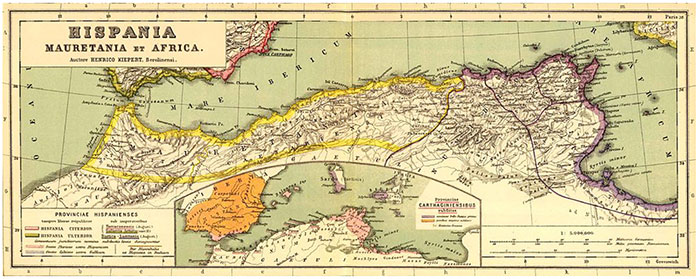
CoinWeek Ancient Coin Series by Mike Markowitz …..
ANCIENT MAURETANIA WAS a region of coastal North Africa stretching from modern-day Algeria to Morocco. It should not be confused with the modern West African nation of Mauritania (spelled differently). The inhabitants of Mauretania were ancestors of the modern people known as Berbers[1]. The Greeks knew them as Mauroi (Μαῦροι). To the Romans, they were Mauri. This term comes into English as “Moor”, a name that has been applied to a variety of African people; for example, Shakespeare’s Othello, the “Moor of Venice.”
Bocchus I

Good Very Fine; ‘desert’ patina.Roma Numismatics Ltd > E-Sale 74. 20 August 2020. Lot : 267 Realized: 110 GBP (approx. 145 USD).
All the Moors were ruled by King Bocchus, who knew nothing of the Roman people save their name and was in turn unknown to us before that time either in peace or in war[2].
The earliest king of Mauretania known to history was Baga, who ruled c.225 BCE from his capital of Chellah[3] (near Rabat, Morocco). The first ruler for whom we have coins was probably Bocchus[4] (or Boccus), who reigned from about 111 to 80 BCE. Some very crude bronze coins are attributed to Bocchus (or possibly his son). A “half unit” of 4.5 grams shows a long-haired bearded head in profile on the obverse and a star between a cluster of grapes and an ear of grain on the reverse[5]. A “unit” of about 9.4 grams shows the same obverse portrait, with a standing figure on the reverse[6].
Camarata
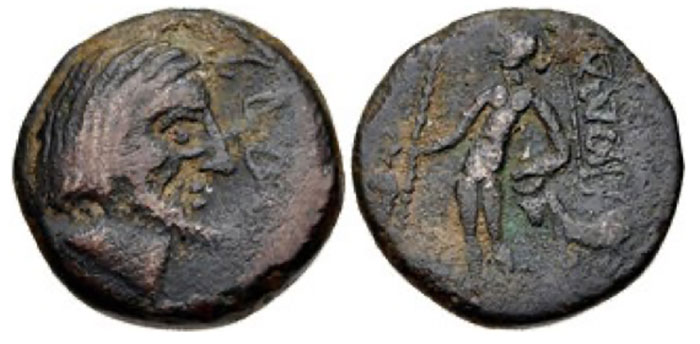
Realized: 575 USD.
Some Mauretanian coins are attributed by city rather than ruler, and they can only be dated approximately – “late 2nd – 1st century BCE”, for example. An example from Camarata[7] (km’ in Punic) bears the same crude male head on the obverse and a cluster of grapes and an ear of grain on the reverse.
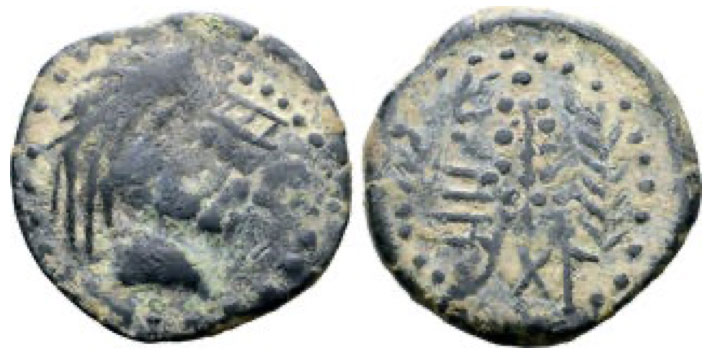
At least a dozen towns in Mauretania issued bronze coins in a variety of denominations for local circulation, ranging from about two grams to nine or more. These included Iol (later “Caesarea” under Roman rule; now Chercell, Algeria), Siga (now Ain Temouchent, Algeria), Timici (now Sidi Bu Sayb, Algeria), Tingis (now Tangier, Morocco), Zilis (now Asilah, Morocco), Lixus (now Larache, Morocco), and Tamusia (or Thamusida, near Kenitra, Morocco).
Bogud
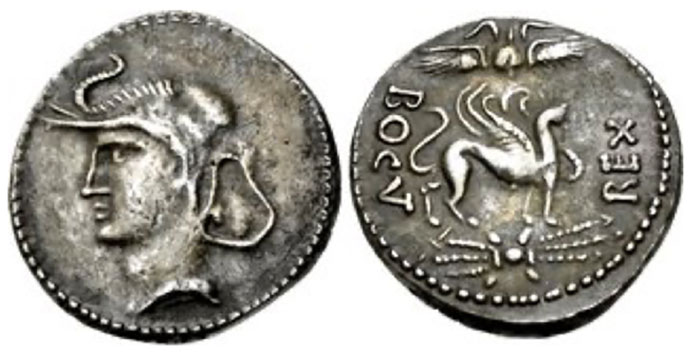
Bogud was the son of King Mastanesosus (for whom no coins are definitely known) who ruled from 80 to 49 BCE. Bogud ruled the western half of the kingdom, while his elder brother, Bocchus II, ruled the eastern half. In the Roman civil wars, Bogud allied with Julius Caesar and later supported Mark Antony against Octavian. Bogud led the Mauretanian cavalry that fought on Caesar’s side at the Battle of Munda[8] in southern Spain (March 17, 45 BCE).

Bogud’s rare coinage in silver was struck on the standard of the Roman denarius (about three grams) and inscribed REX BOCVT in Latin. He adopted the griffin as his personal emblem on coinage. A very rare type bears the personification of “Africa” wearing the elephant headdress[9]. Another type shows a griffin attacking a stag[10].
Bocchus II
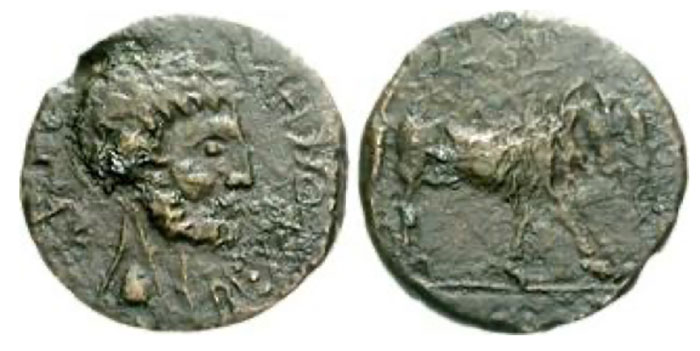
The rare bronze coinage of Bocchus II[11] bears his bearded portrait, with the Latin inscription REX BOCCVS SOSI F (“King Bocchus Son of Sosus”). The reverse shows a walking lion with a Punic inscription BQS HMT (King Bocchus).
Juba II
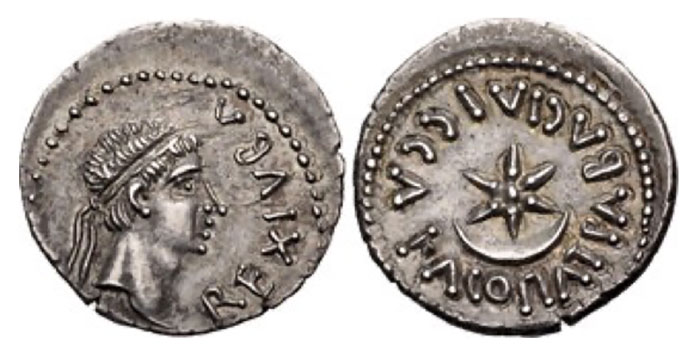
Born about 48 BCE, Juba II was the son of Juba I, who killed himself in 46 BCE after his Roman allies were defeated by Julius Caesar in the civil war. Juba II was brought to Rome where he received an excellent classical education, becoming an accomplished scholar. He fought beside Octavian at the decisive Battle of Actium in 31 BCE. Octavian arranged his marriage to Cleopatra Selene, daughter of Mark Antony and Queen Cleopatra VII of Egypt, and made him king of Numidia.

When Numidia was annexed to the Roman province of Africa, Juba II transferred to become Rome’s client king of Mauretania in 25 BCE. He reigned for a remarkable 48 years, issuing an abundant and handsome coinage in silver and bronze. His capitals were Caesaria (in modern Algeria) and Volubilis[12] (in modern Morocco). Some of his coins are bilingual, with Juba’s name and title in Latin, and Cleopatra’s in Greek[13]. The cornucopia and scepter appear as symbols on some reverses[14]. The denarius usually weighs about 2.6 grams. An exceptional heavy denarius (3.54 grams) bears a magnificent leaping lion. This coin brought £6,000 (over $8,100 USD) in a recent London auction[15]. Some of Juba’s later coins are dated according to his regnal year; for example, a denarius with a walking elephant reverse[16], inscribed RXXXI (Year 31, which corresponds to 6/7 CE.)
Juba & Cleopatra Selene
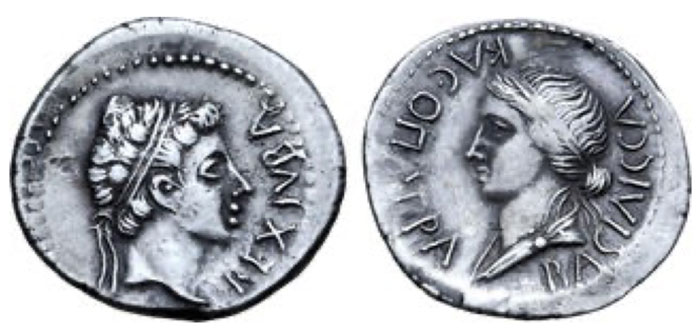
Some very rare coins of Juba II, dated to c. 11-23 CE, are backed with a fine portrait of Cleopatra Selene[17]. She was born about 40 BCE. The date of her death is uncertain, probably between 17 and 23 CE. She bore a son named Ptolemy, after his maternal grandfather, Ptolemy XII Auletes. Juba took a second wife, Glaphyra, a Cappadocian princess, about the year 6 CE, but she does not appear on his coinage.
Juba & Ptolemy

Juba made his son, Ptolemy (born c. 9 BCE) co-ruler in the year 20 CE. Educated in Rome in the household of his maternal aunt, Antonia the Younger, Ptolemy appears together with his father on coins during their co-reign. The Latin inscription around his portrait proclaims REX•PTOLEMAEVS•REGIS•IVBAE F• (“King Ptolemy son of King Juba”)[18].
Ptolemy

Ptolemy reigned for 20 years, traveling widely in the Roman empire and suppressing at least one tribal revolt with Roman military aid. Coins of his sole reign are rare and the standard of workmanship declines considerably from his father’s coinage. A denarius dated to Year 9 (29 CE) shows a crudely drawn, rather cartoonish elephant on the reverse[19]. A bronze coin of about six grams depicts a walking lion that looks more like a cat[20].
Emperor Caligula invited Ptolemy to Rome in the year 40, where he was murdered. According to the historian Suetonius, Caligula was jealous of Ptolemy’s splendid royal purple cloak. With the end of the native dynasty, Mauretania became a Roman province.
Collecting Mauretania
The standard reference for the ancient coinage of Mauretania is Mazard (1955) in French. Long out of print, second-hand copies sell for as much as $250-300, with a later paperback reprint occasionally going for much less. Jean Mazard (1900-1984) was a jurist and numismatist who lived in Algeria and assembled an extensive collection of ancient North African coins. An even earlier work, Müller (1862), is still cited in auction catalog listings.
Many royal Mauretanian coins that appear on the market today derive from a single huge hoard of some 4,000 silver pieces buried c. 17-18 CE near Souk el-Arbaa, Morocco. The “Banasa/El Ksar Hoard[21]” was discovered in 1907 and dispersed to various museums and private (mostly French) collections.
A Memorandum of Understanding (MoU) between the United States and the Kingdom of Morocco signed on January 14, 2021, prohibits the import into the US of: “coins of Numidian, Mauretanian, Greek/Punic, Roman, Byzantine, Islamic, and Medieval Spanish types that circulated primarily in Morocco, ranging in date from the fifth century B.C. to A.D. 1750[22].” Since many ancient Mauretanian coins actually were issued, circulated, and found in Algeria or Tunisia, this underlines the absurdity of such import restrictions that arbitrarily impose the boundaries of modern nations on products of ancient cultures that had a distinctly different geographic extent.
* * *
Notes
[1] Called Imazighen in their own language.
[2] Sallust, Bellum Iugurthinum, Chapter 19.
[3] https://en.wikipedia.org/wiki/Chellah
[4] https://en.wikipedia.org/wiki/Bocchus_I
[5] Roma Numismatics, E-sale 74, August 20, 2020, Lot 267. Realized £110 (about $145 USD; estimate £75).
[6] CNG Electronic Auction 340, December 3, 2014, Lot 219. Realized $575 USD (estimate $200).
[7] https://en.wikipedia.org/wiki/Camarata_(Mauretania)
[8] https://en.wikipedia.org/wiki/Battle_of_Munda
[9] CNG Triton XV, January 3, 2012, Lot 1325. Realized $4,500 USD (estimate $7,500).
[10] Roma Numismatics E-Auction 3, October 25, 2018, Lot 33. Realized £800 (about $1,033 USD; estimate £1,000).
[11] CNG Triton XI, January 8, 2008, Lot 344. Realized $700 USD (estimate $500).
[12] The ruins of Volubilis are a World Heritage Site: https://en.wikipedia.org/wiki/Volubilis
[13] CNG Electronic Auction 470, June 17, 2020, Lot 162. Realized $700 USD (estimate 500).
[14] CNG Electronic Auction 114, May 13, Lot 447. Realized $750 USD (estimate $500).
[15] Roma Numismatics Auction XVII, March 28, 2019, Lot 317. Realized £6,000 (about $8,153 USD; estimate £5,000).
[16] Roma Numismatics Auction XIX, March 26, 2020, Lot 244. Realized £3,200 (about $3,883 USD; estimate £750).
[17] Roma Numismatics Auction XVIII, September 29, 2019. Realized £2,400 (about $2,960 USD; estimate £3,000).
[18] Roma Numismatics Auction XIX, March 26, 2020, Lot 257. Realized £3,000 (about $3,640 USD; estimate £1,000).
[19] Roma Numismatics Auction XIX, March 26, 2020, Lot 258. Realized £2,200 (about $2,670 USD; estimate £1,000).
[20] Leu Numismatic Auction 4, May 25, 2019, Lot 394. Realized CHF 600 (about $596 USD; estimate CHF 350).
[21] http://coinhoards.org/id/igch2307
[22] https://www.govinfo.gov/content/pkg/FR-2021-01-22/pdf/2021-01394.pdf
References
Mazard, Jean. Corpus Nummorum Numidiae Mauretaniaeque. Paris (1955)
Müller, Ludvig. Numismatique de l’ancienne Afrique, Vol. III: Les monnaies de la Numidie et de la Mauritanie. Copenhagen (1862)
Sear, David. Greek Coins and Their Values, Volume 2: Asia and Africa. London
* * *
 Mike Markowitz is “Second Consul” of the Ancient Numismatic Society of Washington. He has been a serious collector of ancient coins since 1993. He is a wargame designer, historian, and defense analyst, who writes for StrategyPage and Defense Media Network. He designed the game Alexandros, which won the 1991 Charles Roberts Award for “Best Pre-WWII Wargame”. He has degrees in History from the University of Rochester, New York and Social Ecology from the University of California, Irvine. He has worked as a technical writer, editor and trainer for a variety of aerospace and defense firms. Born in New York City, he lives in Fairfax, Virginia.
Mike Markowitz is “Second Consul” of the Ancient Numismatic Society of Washington. He has been a serious collector of ancient coins since 1993. He is a wargame designer, historian, and defense analyst, who writes for StrategyPage and Defense Media Network. He designed the game Alexandros, which won the 1991 Charles Roberts Award for “Best Pre-WWII Wargame”. He has degrees in History from the University of Rochester, New York and Social Ecology from the University of California, Irvine. He has worked as a technical writer, editor and trainer for a variety of aerospace and defense firms. Born in New York City, he lives in Fairfax, Virginia.




